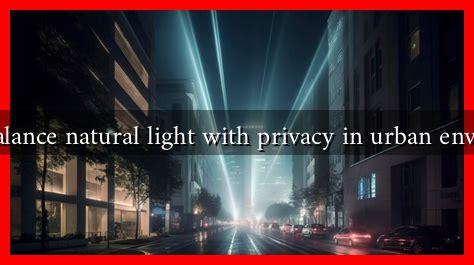-
Table of Contents
Can We Balance Natural Light with Privacy in Urban Environments?
As urban areas continue to grow and evolve, the challenge of balancing natural light with privacy becomes increasingly significant. High-rise buildings, dense populations, and limited space often lead to conflicts between the need for sunlight and the desire for personal privacy. This article explores the complexities of this issue, examining innovative solutions, case studies, and the importance of thoughtful urban planning.
The Importance of Natural Light
Natural light is essential for various reasons, including:
- Health Benefits: Exposure to natural light has been linked to improved mood, better sleep, and increased productivity.
- Energy Efficiency: Utilizing natural light can reduce reliance on artificial lighting, leading to lower energy costs and a smaller carbon footprint.
- Aesthetic Appeal: Well-lit spaces are generally more inviting and can enhance the overall ambiance of a building or neighborhood.
According to a study by the National Institutes of Health, natural light exposure can significantly improve mental health and well-being, making it a crucial element in urban design.
The Need for Privacy
While natural light is vital, privacy is equally important in urban settings. The need for privacy arises from various factors:
- Personal Space: Individuals require a sense of personal space to feel secure and comfortable in their homes.
- Noise Reduction: Privacy often correlates with reduced noise levels, contributing to a more peaceful living environment.
- Social Dynamics: The ability to control visibility into one’s home can affect social interactions and community dynamics.
In densely populated areas, the lack of privacy can lead to increased stress and anxiety among residents, highlighting the need for thoughtful design solutions.
Innovative Solutions for Balancing Light and Privacy
Urban planners and architects are increasingly recognizing the need to balance natural light with privacy. Here are some innovative solutions that have emerged:
- Strategic Building Orientation: Positioning buildings to maximize sunlight while minimizing direct sightlines into living spaces can enhance both light and privacy.
- Use of Screens and Fins: Architectural features such as screens or fins can diffuse light while obstructing direct views into homes.
- Green Spaces: Incorporating parks and green roofs can provide natural light to surrounding buildings while offering privacy through landscaping.
For example, the High Line in New York City is a successful case study that integrates green spaces with urban living, allowing for both light and privacy in a densely populated area.
Case Studies: Successful Urban Designs
Several cities have implemented successful strategies to balance natural light and privacy:
- Copenhagen, Denmark: The city’s focus on sustainable urban design includes the use of light wells and courtyards that allow natural light to penetrate while maintaining privacy.
- Tokyo, Japan: Innovative building designs, such as staggered heights and angled facades, help maximize light exposure while minimizing direct views into residential units.
- Barcelona, Spain: The city’s superblock model reduces traffic and increases green spaces, allowing for more light and privacy in residential areas.
Conclusion: A Path Forward
Balancing natural light with privacy in urban environments is a complex but achievable goal. As cities continue to grow, the importance of thoughtful urban planning cannot be overstated. By incorporating innovative design solutions and learning from successful case studies, urban planners and architects can create spaces that enhance both the quality of life and the well-being of residents.
Ultimately, the challenge lies in recognizing that natural light and privacy are not mutually exclusive; rather, they can coexist harmoniously through careful design and planning. As we move forward, it is essential to prioritize these elements to create urban environments that are not only functional but also nurturing and supportive of human health and happiness.


